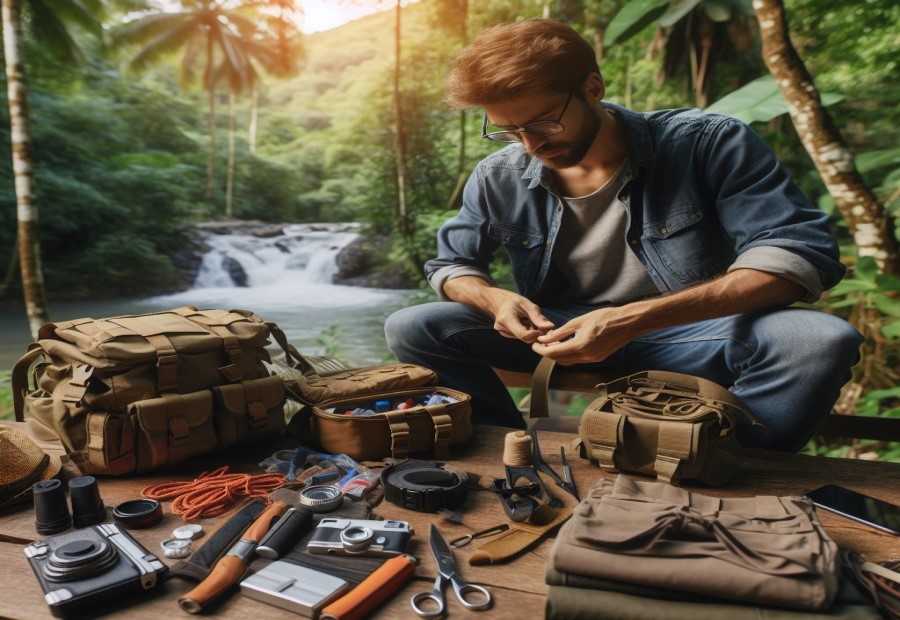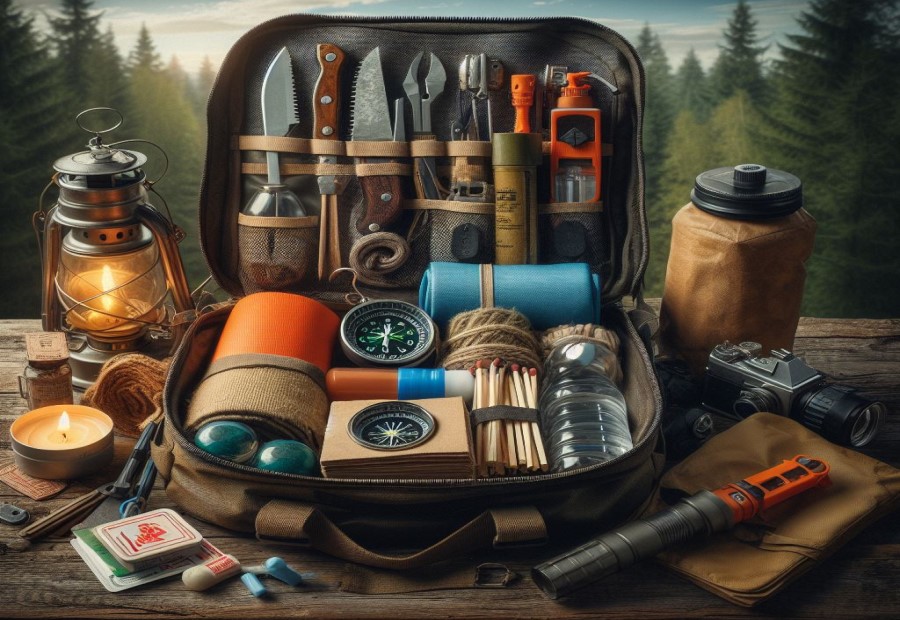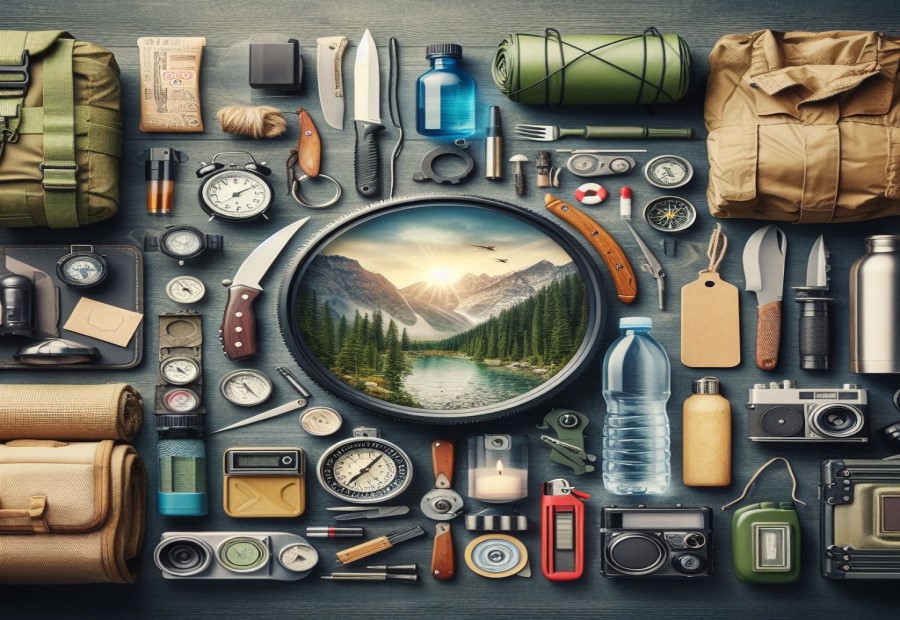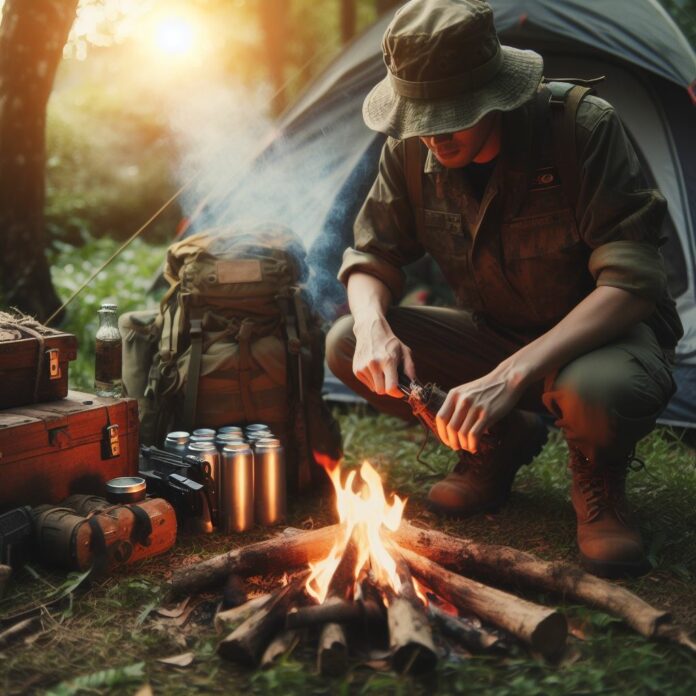Building a survival kit is an essential aspect of preparing for outdoor adventures. Whether you’re going hiking, camping, or embarking on any other outdoor activity, having a well-equipped survival kit can mean the difference between safety and a potential disaster.
We will provide insights on tailoring your survival kit to the specifics of your trip. Factors to consider include the environment and climate you will be encountering, the duration of the adventure, and the level of skill and experience of the individuals involved.
By customizing your kit based on these factors, you can ensure that you are adequately prepared for the challenges you may face.
Proper organization and maintenance of your survival kit are crucial for its effectiveness. We will provide tips on how to organize your kit in a logical and accessible manner, making it easy to locate the necessary items when needed.
Regular maintenance and inspection are also essential to ensure that your supplies are in working order and have not expired or been depleted.
Choosing the Right Container for Your Survival Kit

When building your survival kit for outdoor adventures, one crucial aspect to consider is the right container. With the wide range of options available, it’s essential to choose wisely.
In this section, we’ll explore what factors to consider when selecting a container for your survival kit. From durability to size and portability, we’ll dive into the key aspects that will ensure your kit stays secure and accessible in any situation.
So, let’s delve into the world of containers and find the perfect fit for your survival needs!
What to Consider When Selecting a Container
When selecting a container for your survival kit, there are several factors to consider:
- The material: What to consider when selecting a container is to choose one made from durable and waterproof materials like plastic or metal to protect your items from the elements.
- The size: What to consider when selecting a container is to consider the size of the container based on the number of essential items you need to pack. It should be large enough to hold all the necessary items, but still lightweight and compact for easy transport.
- The accessibility: What to consider when selecting a container is to look for one with easy access, such as one with multiple compartments or pockets, so you can quickly locate specific items when needed.
- The durability: What to consider when selecting a container is to ensure that it is sturdy enough to withstand rough handling and potential impact, especially if you’re going on a rugged outdoor adventure.
- The portability: What to consider when selecting a container is to choose one that is lightweight and easy to carry, either with a handle or straps, so it won’t weigh you down during long hikes or treks.
Considering these factors will help you select a container that is not only practical but also reliable for holding and protecting your survival kit items.
Essential Items to Include in Your Survival Kit

When building a survival kit for outdoor adventures, there are certain essential items that you absolutely cannot afford to leave behind. In this section, we’ll walk through the must-have items that should be included in your survival kit.
So, let’s dive in and get prepared for any situation that may come your way!
Navigation Tools
To effectively navigate during outdoor adventures, it is crucial to incorporate the right navigation tools in your survival kit. Here is a table detailing the essential navigation tools:
| Navigation Tools | Description |
| Compass | A magnetic compass helps determine direction accurately, guiding you towards your intended destination. |
| Map | A topographic map provides detailed information about the terrain, trails, and landmarks, aiding in route planning and orientation. |
| GPS Device | A Global Positioning System (GPS) device utilizes satellite signals to pinpoint your exact location and track your movements. |
| Altimeter | An altimeter measures altitude, helping you determine your position on a topographic map by comparing it with the surrounding terrain. |
| Watch | A watch with a built-in compass and altimeter can assist in navigation and keep track of time, aiding in planning and coordination. |
| Markers | Markers such as ribbons or trail signs can be used to mark specific points or trails to prevent getting lost or retracing steps. |
Including these navigation tools in your survival kit will significantly enhance your ability to navigate through unfamiliar terrain, ensuring a safer and more enjoyable outdoor adventure.
Signaling Devices
The “Signaling Devices” category is an essential component of a survival kit for outdoor adventures. These devices are crucial for attracting attention and signaling for help in emergency situations. Here are some types of signaling devices to include:
- Mirror: A small, lightweight mirror can be used to reflect sunlight and create a visible signal. It is effective for long-range signaling.
- Whistle: A loud whistle can be heard over long distances and can help draw attention to your location. Choose a whistle with a built-in compass for added functionality.
- Flares: Flares are highly visible and create bright, colorful lights that can be seen even in low light or bad weather conditions.
- Signal panel: A brightly colored signal panel or flag can be used to alert search and rescue teams to your location. It is lightweight and can be easily attached to a tree or other elevated location.
- Strobe light: A strobe light emits a powerful flashing light that is visible from afar. It is especially useful in low light or nighttime situations.
Fire-Making Tools
When building a survival kit for outdoor adventures, it is crucial to include the necessary fire-making tools. These tools, such as waterproof matches or a lighter, tinder, kindling, firewood, and a Firestarter, are essential for starting a fire to provide warmth, cook food, and signal for help if needed.
Having these fire-making tools in your survival kit will greatly enhance your ability to create and sustain a fire, increasing your chances of survival and comfort during outdoor adventures. Remember, fire safety is vital, so be sure to carefully control the fire and never leave it unattended.
By adhering to fire regulations and being mindful of your surroundings, you can help prevent accidents. Stay safe and enjoy your outdoor adventures!
Shelter Building Materials
When building a survival kit for outdoor adventures, it’s crucial to include the right shelter building materials. These shelter building materials will not only provide protection but also enhance comfort in challenging environments.
Here are some important shelter building materials to consider:
- Tarp or tent: A reliable shelter can be created using a lightweight and waterproof tarp or tent. They effectively protect against rain, wind, and insects.
- Rope or paracord: Strong ropes or paracord are essential for securing your shelter and building a sturdy framework.
- Tarp clips or carabiners: Ensure a secure and stable shelter by using handy tools like tarp clips or carabiners to attach the tarp to trees or other anchor points.
- Groundsheet or sleeping pad: To insulate yourself from the cold ground and enhance sleeping comfort, include a groundsheet or sleeping pad in your kit.
- Emergency blanket: Lightweight and compact, an emergency blanket provides warmth by reflecting body heat back to you, making it ideal for cold conditions.
- Bungee cords or straps: In windy environments, versatile tools like bungee cords or straps can provide additional support and help secure your shelter.
- Duct tape: Don’t forget to include a roll of duct tape, as it can be incredibly useful for repairing any tears or leaks in your shelter materials.
- Clothing or extra layers: For insulation and warmth, especially in colder climates, pack extra clothing or layers in your survival kit.
When selecting your shelter building materials, prioritize lightweight options that are easy to carry and assemble. Additionally, consider the specific conditions of your outdoor adventure and tailor your shelter materials accordingly.
Water and Food Supplies
To ensure survival, water supplies are crucial as the human body can only survive a few days without water. It is highly recommended to include a water filter or purification tablets in your survival kit to ensure access to clean drinking water.
Carrying reusable water bottles is essential as they are durable and can be refilled whenever needed. To provide sustenance during emergencies, pack non-perishable food items that are high in nutrients.
Include energy bars or protein snacks that are compact and provide quick fuel for the body. Don’t forget to pack cooking and eating utensils to prepare and consume food. A lightweight camping stove or portable grill can also be helpful.
Consider including water purification equipment such as a portable water filter, water purification tablets, or a gravity-fed water filtration system. Emergency rations, such as freeze-dried meals or MREs (Meals Ready to Eat), can provide sustenance for extended periods.
In addition to food and water supplies, it’s essential to pack necessary vitamins and supplements to support overall health and well-being.
First Aid Kit
When preparing a survival kit for outdoor adventures, it is vital to include a first aid kit to handle potential injuries. Here are some essential items to include:
- Bandages: Pack a variety of adhesive bandages in different sizes to effectively dress wounds.
- Gauze Pads: These are useful for controlling bleeding and covering larger wounds.
- Antiseptic Wipes: Use these wipes to clean cuts and prevent infection.
- Medical Tape: This is important for securing dressings and bandages in place.
- Scissors: Include a pair of scissors to cut tape, clothing, or other materials in case of emergencies.
- Tweezers: These can be used to remove splinters, debris, or ticks.
- Pain Relievers: Include over-the-counter pain relievers like ibuprofen or acetaminophen to manage pain and reduce fever.
- Antibiotic Ointment: Apply antibiotic ointment to prevent infection and promote healing of wounds.
- Emergency Blanket: This can help keep someone warm in case of hypothermia or shock.
In addition to these items, it is important to familiarize yourself with basic first aid techniques and procedures. Consider taking a first aid and CPR course to enhance your skills. Remember, a well-prepared first aid kit can make a significant difference in outdoor emergencies.
Multi-Tool
A multi-tool is an indispensable addition to your survival kit. It is a versatile tool that combines multiple functions into one, making it both practical and space-saving.
The importance of a good multi-tool with various tools like a knife, pliers, screwdrivers, a can opener, and a saw cannot be overstated. These tools serve a wide range of purposes, including cutting, prying, screwing, and opening cans or bottles.
By including a multi-tool in your survival kit, you ensure preparedness for different situations and the ability to handle various tasks that may arise during your outdoor adventure. It is crucial to choose a multi-tool made of durable materials to guarantee reliability and longevity.
Make sure to familiarize yourself with the proper use of each tool to maximize its effectiveness in emergency situations.
Communication Devices
In an outdoor survival kit, communication devices are essential for staying connected and calling for help when needed.
1. Two-Way Radios are reliable communication devices that allow you to communicate with others in your group within a certain range. They are compact and easy to use. Make sure to pack extra batteries.
2. Satellite Phones provide communication coverage in remote areas where cell phone signals are unavailable. They are more expensive but can be a lifeline in emergency situations.
3. Personal Locator Beacons (PLBs) are compact devices that can send distress signals to emergency services. They use GPS technology to transmit your exact location, ensuring faster rescue operations.
4. Whistles and Signal Mirrors are simple yet effective communication tools. Whistles can be used to attract attention, while signal mirrors can reflect sunlight to signal for help.
Remember, it is essential to know how to use these communication devices properly and to check their functionality before venturing into the wilderness.
Tailoring the Survival Kit to the Trip

When it comes to building a survival kit for outdoor adventures, tailoring it to the trip is essential. You want to be prepared for the environment and climate you’ll be facing, take into account the duration of your adventure, and consider your own level of skill and experience. But it doesn’t end there.
Organizing and maintaining your survival kit is just as crucial. So, let’s dive into the details of these sub-sections and ensure you’re fully equipped for your next outdoor excursion!
Consider the Environment and Climate
When preparing a survival kit for outdoor adventures, it is vital to give careful thought to the environment and climate you will encounter. Several factors should be taken into consideration:
- Temperature: It is important to evaluate the average temperature range of the area you will be in. This will determine the appropriate clothing, sleeping gear, and shelter materials needed.
- Precipitation: It is crucial to determine the amount of rainfall or snowfall in the region and make necessary preparations. Waterproof gear, tarps, and fire-making tools are essential in wet environments.
- Altitude: The elevation of the area must be taken into account as it impacts temperature, oxygen levels, and terrain. It is crucial to have suitable clothing to protect against altitude-related challenges like hypothermia or sunburn.
- Vegetation: Familiarizing yourself with the foliage and plant life in the area is important. Some plants may offer edible food sources, while others may be harmful or toxic.
- Wildlife: Conduct research on the wildlife inhabiting the region and take appropriate precautions. Implement measures such as storing food securely and carrying bear spray in bear-populated areas.
Duration of the Adventure
When planning an outdoor adventure, it is important to consider the duration of your trip to ensure that your survival kit is adequately prepared. The length of your adventure will determine the amount of supplies and provisions you need to carry with you.
| Short Duration Adventure: | If you are embarking on a short-duration adventure, such as a day hike or a weekend camping trip, it is crucial to consider the duration of the adventure. Focus on carrying essential items that can sustain you for the entire duration of your outing. Pack enough food and water to last for the duration of your trip, along with basic navigation tools like a map and compass to help you stay on track. |
| Extended Duration Adventure: | For longer adventures, such as multi-day hikes or backpacking trips, considering the duration of the adventure is vital. It is essential to pack additional supplies that can support you throughout the entire duration. Consider carrying a larger quantity of water or a water filter for replenishing your water supply along the way. Pack enough food to provide sufficient calories and nutrients for each day. Additionally, you may need to include extra clothing, shelter building materials, and fire-making tools to ensure your safety and comfort throughout the duration of the trip. |
By considering the duration of your adventure, you can tailor your survival kit to meet your specific needs and ensure that you are adequately prepared for any challenges that may arise during your outdoor excursion.
Level of Skill and Experience
To determine what level of skill and experience is needed for your survival kit, consider the following factors:
| Factor | Level of Skill and Experience |
| Outdoor survival knowledge | Basic understanding of survival skills, such as navigation and fire-making |
| Physical fitness | Average level of fitness to endure outdoor challenges |
| Previous outdoor experiences | Prior experience with camping, hiking, or other outdoor activities |
| Emergency response training | Basic knowledge of first aid and emergency procedures |
| Terrain expertise | Familiarity with the specific environment and its challenges |
| Survival mindset | Positive attitude, adaptability, and problem-solving skills |
Assessing your level of skill and experience is crucial for selecting the appropriate items to include in your survival kit. Beginners may focus on basic tools and supplies, while experienced adventurers can opt for more specialized equipment.
Always prioritize safety and ensure that your skill level matches the demands of your outdoor adventure.
Organizing and Maintaining Your Survival Kit
To effectively organize and maintain your survival kit, follow these steps:
- Inventory: Regularly check your survival kit to ensure all items are present. Make a checklist and mark off each item as you inspect it.
- Expiration dates: Check the expiration dates of perishable items such as food, batteries, and medications. Replace these items as needed to ensure they are effective when needed.
- Organization: Arrange your items in a logical and easily accessible manner. Use separate compartments or bags to keep similar items together. This will help you quickly find what you need in an emergency.
- Labeling: Clearly label each compartment or bag with the contents inside. This will further aid in locating specific items and maintaining organization.
- Regular checks: Routinely inspect your survival kit for any damage, wear, or missing items. Replace or repair any damaged items and replenish any missing supplies.
- Maintenance: Regularly clean and sanitize your survival kit to prevent the growth of bacteria or mold. This ensures that your supplies remain safe and usable.
- Accessibility: Keep your survival kit in an easily accessible location. You don’t want to waste time searching for it during an emergency. Consider storing it in a designated area or keeping it within reach when embarking on outdoor adventures.
- Review and update: Periodically review and update your survival kit based on changing needs, environmental conditions, or personal requirements. Stay informed about new equipment or techniques that may enhance your preparedness.
By following these steps, you can effectively organize and maintain your survival kit, ensuring that it is prepared to support you during outdoor adventures and emergencies.
Frequently Asked Questions
How do I start a fire in the wilderness?
To start a fire in the wilderness, you can use a variety of fire-starting tools such as waterproof matches, a lighter, a flint bar, or a magnesium and flint striker. Make sure to gather dry tinder, kindling, and fuel wood before attempting to start the fire.
Once you have gathered the necessary materials, strike the fire-starting tool against the flint bar or magnesium bar to create sparks that will ignite the tinder. Gradually add the kindling and fuel wood to build the fire.
What should I pack for unexpected overnights in the wilderness?
For unexpected overnights in the wilderness, it is important to pack a few essential items in your survival kit.
These items include an ultra-light tube tent or a space blanket for shelter, a headlamp or flashlight for light, a protein bar or dried food for sustenance, a pocket knife or versatile multi-tool for various purposes, and a larger water vessel or hydration bladder for water storage.
Additionally, consider including a first aid kit with bandages, antibiotic salve, alcohol swabs, broad-spectrum antibiotics, and any necessary medication for specific health needs.
What gear should I bring for mountain biking in remote areas?
When mountain biking in remote areas, it is essential to carry a few key items in your survival kit for potential emergencies.
These items include a pocketknife or multi-tool for various functions, a signaling mirror for attracting attention, a space blanket or plastic poncho for shelter, a water-filter straw or purification tablets for safe drinking water, and a versatile pain reliever or anti-diarrhea medicine for any unexpected health issues.
Additionally, pack some fishing supplies, such as fishing line and fishhooks, for a potential food source.
What are some recommended navigation tools for outdoor adventures?
For outdoor adventures, it is important to have reliable navigation tools to avoid getting lost. Consider bringing a map of the area and a compass as a backup to your phone’s navigation.
If you prefer more advanced navigation, investing in a GPS watch can provide accurate positioning and tracking. Remember to familiarize yourself with the tools and how to use them before heading into unfamiliar territory.
What should I pack for a lightweight survival kit?
A lightweight survival kit should include essential items that can significantly increase your chances of survival without adding excessive weight.
These items include fire-starting tools like waterproof matches, a lighter, and a flint bar, an ultra-light waterproof and windproof running jacket for protection against changing weather conditions, a versatile multi-tool for various tasks, and a compact, efficient space blanket for shelter.
Additionally, pack lightweight, calorie-dense ready-to-eat foods like protein bars, a water bottle and/or hydration bladder for hydration, and a first aid kit with basic medical supplies.
How should I efficiently pack my survival kit for outdoor adventures?
Efficiently packing your survival kit is important to maximize space and accessibility. Place heavier items on the bottom of the kit to balance the weight and make it easier to carry. Group similar supplies into compartments or use small bags or zip-lock bags for organization.
Utilize straps or bungee cords to secure any loose items and prevent them from shifting during travel. Regularly inspect and practice with your kit to ensure you are familiar with its contents and are prepared for emergencies.

